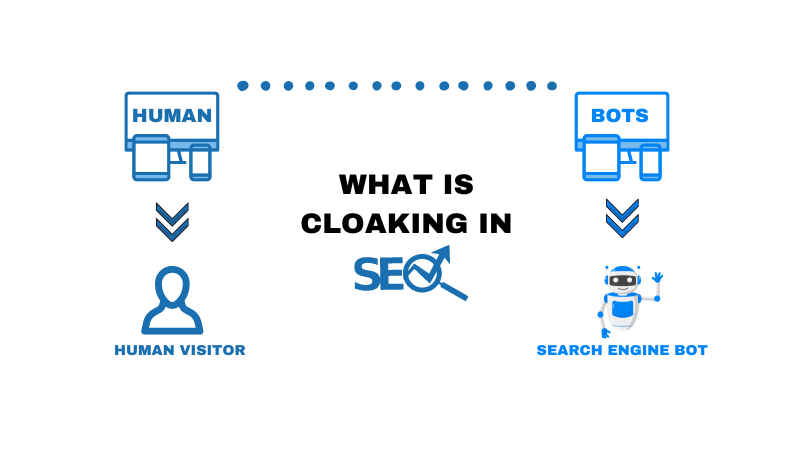
A high SERP ranking is important for your website, but not all SEO strategies are pleasant or helpful.
Cloaking in SEO is a practice that can get your site banned or blacklisted. If you’re interested in becoming a marketer, check out this essential information.
Search engines don’t like unethical strategies such as cloaking, which can get a site ahead initially, but still violate their guidelines.
A website that is caught doing this may be heavily penalized or even banned by Google.
In this article, we’ll talk about what you need to know about cloaking in SEO to stay safe and legal.
What Is Cloaking in SEO
Cloaking is the process of presenting content or information to users that is different from what is presented to search engines.
A website must provide information to search engine spiders or bots, in order to increase its search engine rankings for certain keywords.
During cloaking, the server of the website is specifically programmed to serve different content to search engines than it does to regular site visitors.
What is Cloaking in SEO with an Example?
In search engine optimization, cloaking involves misleading search engine crawlers into believing that the page’s content is different than it actually is.
Examples of cloaking SEO include:
- Search engines see a page of HTML text, while users see images or Flash files
- The keyword should only appear in the content when the search engine page is requested, not when human visitors access it.
Why Should You Avoid Cloaking in SEO?
Other cloaking and black hat techniques SEO does not technically break any laws, so you can’t really be jailed for doing them.
You don’t want to follow these practices if you’re serious about achieving and maintaining a high ranking in Google’s SERPs (Search Engine Results Pages).
Here’s more about why you should stay away from it.
You May Be Penalized
Cloaking is a type of black hat SEO that can get your website a heavy penalty from Google, whether you know it or not.
As a result, all the hard work you’ve put into your site could be lost in an instant, because your search engine rankings will drop a lot.
Once a site is penalized by Google, it is extremely difficult to recover.
This can damage your brand
You should keep in mind that a process that does not properly support search engine users is not beneficial for your organization.
People don’t like being tricked. If your audience knows that’s what you’re going to do, they’ll leave.
What else could you do to save money or time if you’re willing to use “black hat” techniques like “cloaking” in SEO?
By doing this, you will lose your customers’ sense of audience trust, and this will be the exact opposite of what you want with your brand-building efforts
Your site could be banned
Google can impose more severe penalties on sites caught cloaking. It could be completely and permanently banned.
It is called a “manual penalty,” and it is even more difficult to get over.
When a site is completely removed from Google’s indexing system, it can no longer be found using keywords and key phrases.
After fixing your site, you might be able to ask Google to look at it again, but this is not a sure thing.
How Do You Know if a Website is Cloaking?
Cloaking sites can be detected for several reasons.
In any case, you’ll want to know whether a website you’ve visited is potentially untrustworthy.
There is no doubt that cloaking indicates that you are not safe on that site, and you should avoid it.
However, your own website may also become a target of hackers in the future.
Here are some techniques to identify cloaking in SEO before it can hurt you or hurt your SERP rankings.
Compare the SERP result with the original page
When Google displays a link to one of its SERPs, you will see words related to your search term bolded in the description.
When you visit that page, you should naturally see the same text somewhere, right? If you don’t see it, it is a sign that something is wrong, and the site could be cloaking.
Shady SEO techniques
A website that uses one less-than-savory SEO technique probably uses others, as well.
Beware of low-quality, spammy content, keyword stuffing, out-of-place backlinks that may have been purchased, etc.
This isn’t a strong indication that the site is even cloaking, but it’s a sign that the way it’s set up leaves a lot to be desired.
Online Cloak Checker
Online cloak checkers like SiteCheckerPro or SmallSEOtools Cloaking Checker can help you determine whether a site is cloaking.
You can use online cloak checkers like SiteChecker or SmallSEOtools Cloak Checker to find out if a site is cloaking.
You don’t have to pay to use these tools; they are easy to find and they work. The tool can not only tell you if a site uses cloaking, but it can also scan pages for hidden scripts.
Making cloak-checking part of your regular site audit is a good idea for your site.
By using this method, you can make sure that your site is safe and follows Google’s rules for webmasters.
To protect your search rankings and the overall integrity of your website, take action immediately if you find something. paying back
Conclusion
Cloaking is not really worth the trouble for a website when it comes to SEO optimization.
There are so many alternatives out there that provide real success that you can grow with, that the quick SERP gains and easy fixes aren’t worth the fines or bans imposed by Google.
FAQ’s
What is Cloaking?
Cloaking is a search engine optimization technique in which the content shown to the search engine spider is different from the content shown in the user’s browser.
This is done by sending content to the user based on his or her IP address or the User-Agent HTTP header.
Is Cloaking Black hat SEO?
Yes, of course! Cloaking is a black hat SEO technique in which the original viewer of a website sees one URL, page, or piece of content while the search engines see another.
Is cloaking real?
The practice of cloaking is very real. There are some websites that use this technique to generate traffic on their website at the expense of their users’ experience.
“Click baiting” is when a user clicks on a link expecting to find information related to their search, but the link doesn’t lead them to the information they were looking for.
It is recommended that websites avoid using this technique.

Factsinsight.com is a leading blog that focuses on creating high quality, interesting and useful content about technology. We are a group of experienced writers who know a lot about the world of tech and love to stay abreast of the latest trends and developments. Our aim is to give useful and real knowledge to our people.
